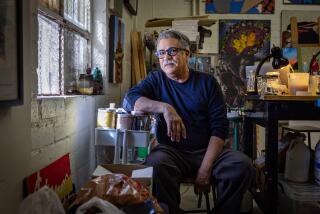William T. Wiley retrospective at Berkeley Art Museum
Bay Area artist William T. Wiley’s career could easily be viewed as a historical timeline of political and social issues of the last half century, touching on hot topics, including the Exxon Valdez oil spill of 1989, the 1986 Chernobyl meltdown, 9/11 and issues of government-supported torture.
“What’s It All Mean: William T. Wiley in Retrospect” at the Berkeley Art Museum offers a vibrant glimpse of the artist’s California-centric work. The exhibition, which originated at the Smithsonian Art Museum last fall, includes 80 pieces that include watercolors, drawings, sculptures, books, film and even a pinball machine.
“He’s a local hero,” said curator Priscilla Barnes of Wiley, 72, who resides in Marin County. “He’s had an exploding career that has maintained throughout the years.”
Wiley’s body of work has been described as whimsical, poignant, introspective, provocative, convoluted, zany and self-indulgent. His kaleidoscopic collages meld a mishmash of paintings, handwritten verse, metaphysical symbols and found objects. Don’t be fooled, every element is painstakenly intentional.
Born in 1937 in Bedford, Ind., Wiley attended the San Francisco Art Institute, where he received his MFA. He taught at UC Davis for five years, counting Bruce Nauman as one of his students. “As a kid I wanted to be an artist in the same vein as Fred Harman,” said Wiley of the creator of the “Red Ryder and Little Beaver” cartoon strip.
A founder of the West Coast Funk art movement of the 1960s that included Robert Arneson, Robert Hudson and Roy DeForest, his style expanded on abstract expressionism as a reaction to minimalism and Pop Art. “In the mid-’60s, social and environmental issues were really breaking open and becoming visible, making the work quite easy,” he said.
A wordsmith known for his use of puns, he credits his father and traveling back and forth across the country from age 11 to 13. Wiley spent part of his youth growing up around the Hanford site, the contaminated nuclear site in Washington state, stirring his imagination and setting him on a course of creating a melange of visual tales intertwined with social commentary and political observations. Several of his pieces deal with the consequences of environmental pollution.
“Art Official Peace Plan” was motivated by his opposition to the Vietnam War. A recycled Christmas tree stripped bare of its branches was bent to form a peace symbol crafted from vines, twine and rawhide. At the base are scattered wooden slingshots with the word “peace” written on the straps. A working global-warming themed pinball machine, “Punball: Only One Earth,” is also on display.
The soft-spoken artist often inserts a droll alter ego in his work such as the long-nosed clown in the pinball machine.
The charcoal and colored pencil drawing “Mr. Unatural Eyes the Ape Run Ledge,” a response to R. Crumb’s Mr. Natural character, mirrors his own awkwardness with a lanky, language-averse, bathrobe-wearing dunce.
The exhibition runs through July 18.
More to Read
The biggest entertainment stories
Get our big stories about Hollywood, film, television, music, arts, culture and more right in your inbox as soon as they publish.
You may occasionally receive promotional content from the Los Angeles Times.






